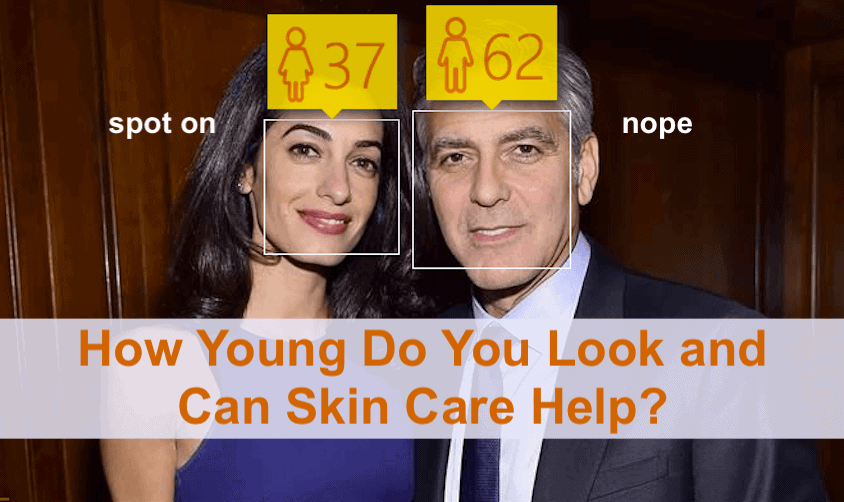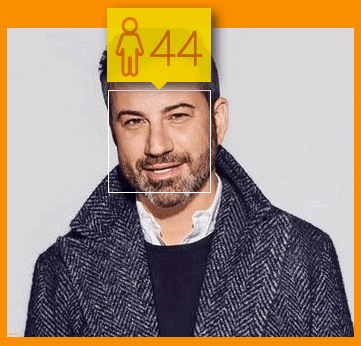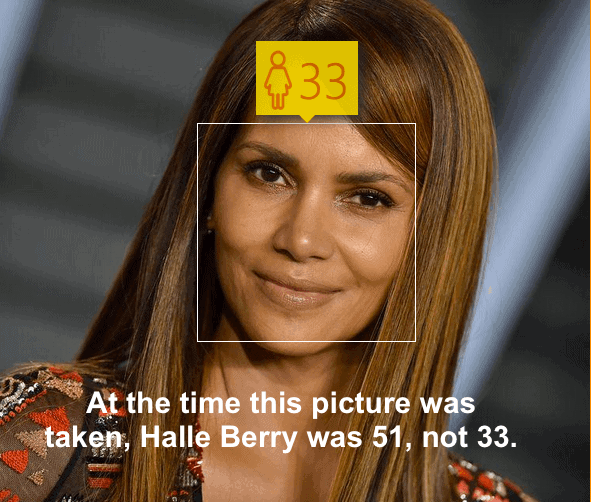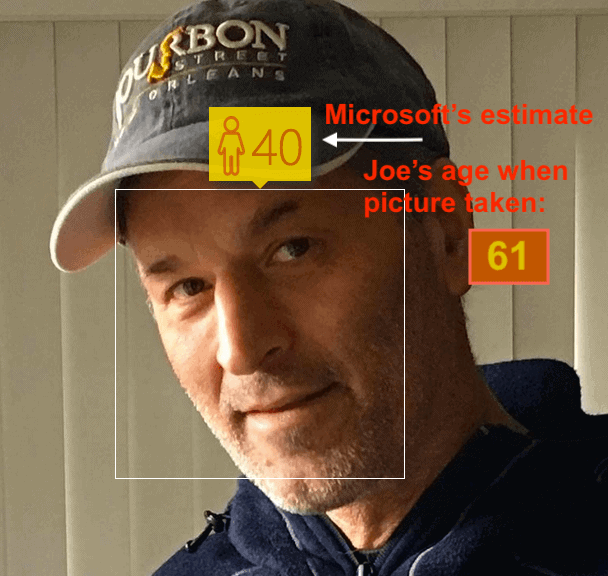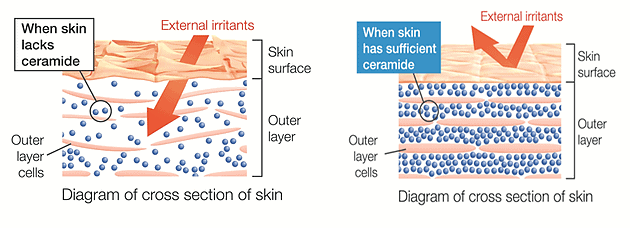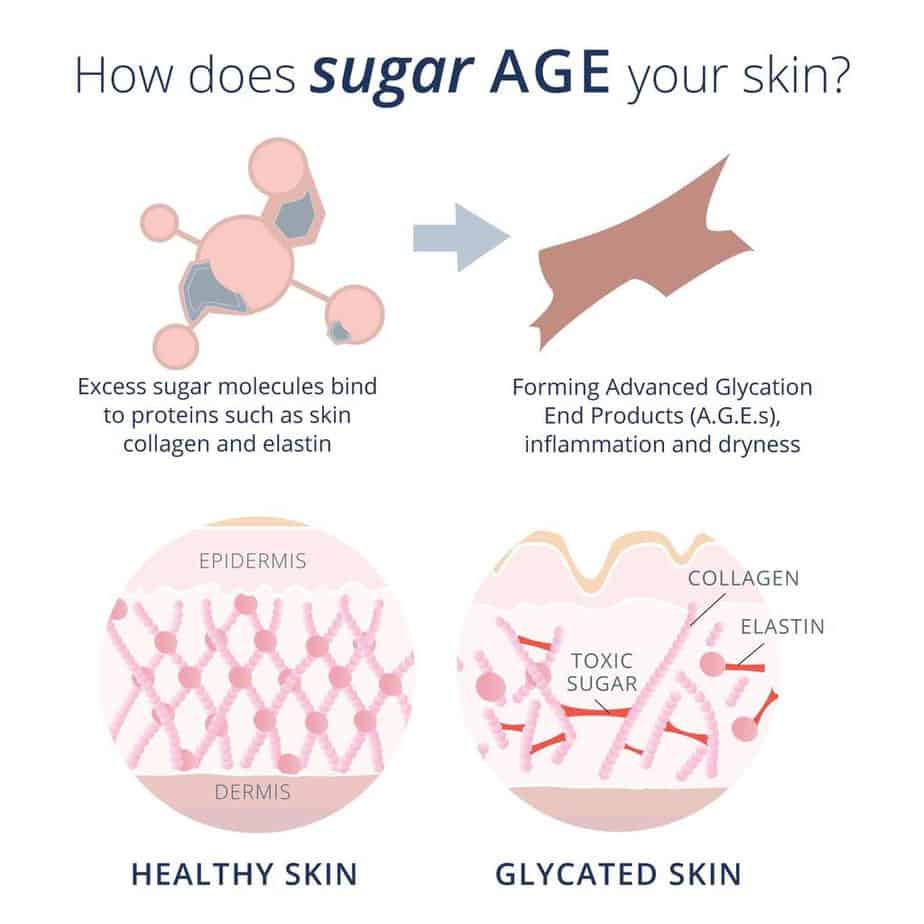How Young Do You Look and Can Skin Care Help?
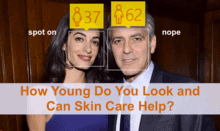
Rather than worrying how old you look, lets focus on how young you look, or could. I’ll show you Microsoft’s age-estimating app based on your face, but what really matters is how young do you want to look and feel? Here are examples and guidance.
HOW YOUNG do you look?
When someone tells you that someone looks young (or old) for his/her age, what firsts pops into your head?
Surely you conjure some standard reference point for what someone of that age looks like. And that “look” you’re looking at is mainly the person’s skin.
Even though the quality of our youthfulness is mostly dependent on how we feel and how our bodies move, the look of our skin seems to be what’s first noticed.
Wrinkly and sagging skin = old.
Smooth, tight skin = young.
And that’s why skin care is a multi-billion dollar industry.
Although how you look is much less important than what you can do and how you think, it’s mighty fine to look younger than your chronological years. So, let’s take a look how that could happen, the focus being skin; particularly the skin on your face.
If you’d like to jump ahead to your topic of interest, go ahead:
Let’s dig in…
How Young Do You Look?
We begin with uploading pictures to Microsoft’s age estimating website, called How-Old.net.
The pics up top and just below are of George Clooney and his wife, Amal. At the time the photo was taken, George was 54 years old and Amal was 37. Microsoft’s How-Old.net correctly estimated Amal’s age, but over-reached with George Clooney, guessing him to be eight years older than he was at the time.
For a moment or two, I toyed with the idea of having How-Old.net guess the ages of a few family members and friends, but upon reflection decided I rather not be forever shunned. Better to stick with celebrities whose ages we know and who can’t get too pissed at me for uploading their pics to the Microsoft age estimator given that they’re public figures.
OK, then, Mr. Microsoft age estimator, how old does Jimmy Kimmel and Halle Berry look?
Apparently, Jimmy Kimmel looks youthful enough that Microsoft age estimating app guessed him to be six years younger than is his real age, but, damn, Halle Berry really rocked it! The app estimated Ms. Berry’s age to be 18 years younger than she is.
This is unsurprising, because Halle Berry does everything imaginable to keep her youthful look and physical capacity — she does resistance and cardio training, supplements with various vitamins and superfoods and eats healthily. And it shows!
Naturally, I couldn’t resist uploading a pic of myself (and surely you’ll do the same.):
Ha! Looks like Halle’s got nuttin on me. (Well, except beauty, fame and fortune — but why quibble.)
If you choose to upload your own pic to How-Old.net and are unhappy with the result, or the mirror is all the motivation required, this is what you need to know about:
- Diet,
- Ceramides,
- Glycation,
- Sun Damage, and
- Develop your skin aging battleplan.
First Off, You Need To Eat Right To Retain/Improve Skin Quality
In a bit, I’m going to share some lotions and potions that might help you reduce wrinkles and sagging skin, but if your diet is crap, you’d be wasting your money on such things.
As you’ll see and hear in the video below, nutritional expert, Michael Greger, M.D. makes these five points about the effect of nutrition on skin quality:
- The skin is the largest organ in the body—about 20 square feet—and is the most vulnerable organ in the body, exposed to both the oxidizing effects of UV radiation from the sun and the oxidizing effects of oxygen in the air.
- Over the years, skin becomes thinner, more easily damaged, loses volume, elasticity and can sag and wrinkle, due to oxidative stress, inflammation and ischemia (lack of adequate blood flow).
- Oxidative stress means we need the abundant antioxidants found in plant food, and reduce consumption of foods that cause inflammation and ischemia, which mainly are processed foods, conventionally raised meat and too much diary.
- In particular, a high intake of vegetables, beans, peas, lentils, soy and olive oil appeared to be protective against skin wrinkling; whereas “a high intake of meat, dairy and butter” appeared to have an adverse effect. Prunes, apples, and green tea appeared especially protective.
- A recent study, for example, found that green tea phytonutrients were able to protect skin against harmful UV radiation, and help improve skin quality of women. After a few months on green tea, there was a 16% reduction in skin roughness, and a 25% reduction in skin scaling.
So, how young do you look?
If your answer is “not young enough”, begin with your diet.
And then keep going…
You Need To Replenish Your Skin’s Ceramides As You Age
Ceramides are lipids (fats) found naturally in high concentrations in the uppermost layers of skin. They make up over 50% of skin’s composition and are essential in supporting the skin barrier, retaining moisture and determining how your skin looks.
Without ceramides, skin can become dry, itchy, or irritated. When ceramide levels are low, the skin barrier is weakened, allowing moisture to escape from skin. Applying ceramides directly to skin helps restore its barrier and retain moisture.
The Life Extension Foundation has three articles about ceramides that might be of interest to you (1, 2, 3). Here’s a bullet point summary of them:
- Ceramides are natural lipid molecules with the critical capacity to preserve youthful-looking skin by maintaining the skin’s water-retaining properties.
- These ceramides, which naturally occur in the multiple layers of human skin, may give the moist, plump, wrinkle-free appearance seen in the young and can defend against certain skin diseases and infections.
- They critically keep up the water-retaining properties of the skin by blocking water loss from aging or physical trauma.
- Unfortunately, the skin content of ceramides substantially decreases with age.
- A remarkable new study now demonstrates that these strong anti-aging effects can also result in significant fine line- and wrinkle-reduction. (See “An Important Ceramides Study” below.)
- Over the years, placebo-controlled, clinical studies have shown that a unique plant-ceramide extract, taken orally, boosts skin hydration, suppleness, smoothness, and other measures of youthful skin.
- Natural phytoceramides can be taken orally, allowing them to enter the bloodstream where they are naturally transported through all layers of the skin, working from the inside out.
- Expensive skin creams have contained ceramides for decades now, but aging people find that these surface ceramides deliver only modest improvement.
- Placebo-controlled, clinical studies show that oral wheat-derived phytoceramides boost skin hydration, smoothness, suppleness, and other measures of youthful skin. Ceramides also defend against skin-based infections and diseases.
An Important Ceramides Study
The latest clinical study of ceramides affect on skin cited by Life Extension Foundation was a 2017 study that demonstrated how plant ceramides can reduce fine lines and wrinkles. It also showed improvements in features of the skin’s barrier function that are typically lost to aging and environmental exposure.
The study randomized of 64 women aged 42 to 66 into two groups of equal size. The women took either 350 mg of a plant ceramide extract, or one identical placebo, daily for 12 weeks. A variety of scientific measures were taken.
The results of this study showed the oral ceramide supplement:
- Increased skin hydration for 75% of the women after four weeks,
- Increased skin hydration for 90% of the women after 12 weeks,
- Visibly reduced wrinkles around the eyes (crows’ feet) for 88% of the participants after 12 weeks,
- Improved radiance and reduced dullness around the eye area after eight weeks and
- Visibly reduced wrinkles through week 20 (even after discontinuation of ceramide supplementation), showing long-term benefits.
Topical Lotion or Oral Supplementation
You basically have two options to replenish your own body’s declining production of ceramides:
- Topical Lotion
- Oral Supplements
As you’ve just read, the studies show that oral supplementation is likely more effective. Life Extension Foundation, the author of the three ceramides articles above summarized, offers a ceramides supplement called, Skin Restoring Phytoeramides.
If lotions are more to your liking, Paula’s Choice is a skin care brand that seems to be highly rated. As any consumer-facing company should do, they break things down in layman’s terms in their answer to two questions.
(1) What do ceramides do?
“Think of ceramides as the mortar between bricks—if the bricks are your skin cells. Ceramides help hold skin together by forming a protective layer that limits moisture loss and protects against visible damage from pollution and other environmental stressors. In addition, ceramides—even more than retinol, niacinamide, and peptides—are one of the anti-aging “powerhouses” responsible for supporting skin’s dynamic nature. Two particular ceramide precursors—phytosphingosine and sphingolipids—actually help skin make more ceramides.”
(2) If my skin already has ceramides, why do I need them in my beauty products?
“Age and sun damage reduce the effectiveness of your skin’s natural ceramides—and can eventually deplete them, which weakens your skin’s barrier. The results are drier, rougher skin, wrinkles, irritation, redness, and visible signs of dehydration. This is where skincare knowledge comes into play—because it really is possible to significantly restore what’s been diminished.”
Paula’s Choice offers its Clinical Ceramide-Enriched Firming Moisturizer and, as mentioned, Life Extension Foundations offers its Skin Restoring Phytoeramides capsules:
You Need To Protect Your Skin From Glycation As You Age
Writing for Life Extension Foundation, clinical dermatologist Dr. Gary Goldfaden says:
At this very moment, a destructive process called glycation is aging your skin from the inside out. In fact, researchers recently uncovered compelling evidence that stresses “the importance and possibly central role of glycation in skin aging.”
Dr. Golfaden goes on to explain that glycation occurs when sugar molecules bind to proteins like collagen in living tissues, and culminates in the formation of deadly complexes called advanced glycation end products (AGEs). This in turn significantly disrupts collagen metabolism and paves the way for wrinkles, creping, and loose skin.
Here’s what you need to know:
- Glycation refers to a spontaneous reaction between sugar, such as fructose and glucose, and proteins like collagen that reside in the skin’s vital matrix.
- This culminates in the formation of advanced glycation end products (AGEs) that cause damage to collagen molecules, leading to wrinkles, creping, and loose skin.
- Scientists have identified topical nutrients, including Terminalia chebula fruit extract, pentapeptide-34 trifluoroacetate, blueberry extract, hexapeptide-3, and pomegranate extract, that work in complementary ways to protect the skin against the harmful effects of glycation as we age and promote dermal regeneration.
- As part of a comprehensive approach that includes reducing sugary foods and refined carbohydrates, as well as proper cooking methods, these compounds, proven clinically or in the lab, reduce glycation and AGE formation to preserve the skin’s youthful appearance.
To help protect against the wrinkles and sagging skin caused by glycation, Dr. Goldfaden suggests you use specific topical nutrients. Life Extension Foundation offers both a topical and oral product.
Two points about Carnosine as concerns skin health:
- Carnosine is a dipeptide consisting of amino acids beta-alanine and L-histidine. It inhibits glycation, a natural chemical reaction that can contribute to a variety of age-related factors.
- Carnosine may be the most potent glycation-inhibiting nutrient. As previously noted, glycation affects essential proteins in your body, and can be superficially seen as wrinkled skin.
You Need To Protect Your Skin From the Sun (etc.) As You Age
Self-proclaimed skincare fanatic Lindsey Metris, Managing Editor of the online beauty shop, Byrdie, wrote in her anti-aging skin care piece that as we age, our skin goes through two different and major forms of aging: intrinsic and extrinsic.
Intrinsic aging refers to aging that occurs internally, such as thinning of the epidermis (the top layer of skin), and the loss of the skin’s strength and elasticity. The sebaceous glands also begin to produce less oil, which leads to dry, crepey skin, says Ms. Metris.
Extrinsic aging refers to environmental and lifestyle choices that affect skin, such as smoking and sun exposure. Ms. Metris goes on to say that although “we can’t technically prevent intrinsic aging [which is somewhat contradicted by the material offered above about ceramides and glycation], there are several science-backed ways we can put up a shield to external factors thanks to the help of hardworking products.”
She then beaks out dermatologist-recommended products within the categories of:
- Sunscreen
- Retinol
- Glycolic Acid
- Dark-spot Correctors
Let’s take a quick look at each.
Sunscreen
Looks to me like sunscreen provides the biggest bang for the buck, particularly given that the sun accounts for 70% of skin damage.
Rachel Nazarian, MD puts it this way:
“The simplest anti–aging product for your body is a broad-spectrum sunscreen that blocks UVA and UVB rays. It is much easier to prevent the aging effects of the sun and environmental factors than it is to treat the damage they can cause. My favorite sunscreen right now is EltaMD.”
Jeremy Brauer, MD, agrees:
“The best products for anti–aging are broad-spectrum UVA/UVB protective sunscreens and UPF/SPF sun-protective clothing (hats, shirts, gloves) that all help to prevent the sun damage in the first place.”
Retinol
Retinol slows the loss of elastin, prevent the rise of collagenase (the enzyme that breaks down collagen), and lighten discoloration in addition to minimizing the look of fine lines, says Byrdie Editor, Lindsey Metris. Just-mentioned dermatologist, Dr. Bauer praises retinol for its “skin-thickening” abilities:
“The best topical overall is use of a retinoid-/retinol-containing product that has been shown to help stimulate new collagen.”
Paula’s Best RESIST Intensive Wrinkle-Repair Serum is recommended as a good retinol-based skin care tonic.
Glycolic Acid
Gervaise Gerstner, MD like glycolic acid:
“The best anti-aging products for the body that I recommend is glycolic acid. I personally use 20% glycolic pads.”
Dark-spot Correctors
OK, now we’re getting into the weeds, I think. But if you want the whole enchilada, know that sun exposure can lead to hyperpigmentation and aging indicators like liver spots on the skin.
If you’re intent on lightning some dark spots on your skin, Dr. Brauer suggests SkinMedica Lytera 2.0, and SkinCeutical’s Discoloration Defense. He likes these because they lack hydroquinone, a skin-lightening ingredient found in some dark-spot treatments that has side effects such as burning, stinging, redness, and severe dryness.
Your Battleplan to Combat Aging Skin
For those of you who at this point have only whetted your appetite for all-things-skincare, take a deep dive into my three-part series on the subject, Your Battleplan to Combat Aging Skin. Begin with Part 1:
Typically the fastest way you can get a sense of a person’s age is by their skin. The more skin sags and is wrinkled, the older a person appears. You can fight back.
Your Takeaway
If you want the answer to the question, “How young do you look?” to be “Much younger!”, do these five things:
- Eat real food, mostly plants
- Replenish your skin with ceramides
- Attack glycation with carnosine
- Use a high quality sun screen if you’re in the sun for 20 minutes or longer
- Try some retinol lotions
Last Updated on April 6, 2019 by Joe Garma

